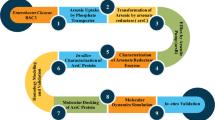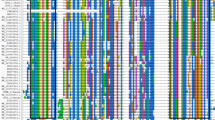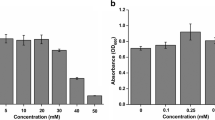Abstract
ArsD is a metallochaperone that delivers As(III) to the ArsA ATPase, the catalytic subunit of the ArsAB pump encoded by the arsRDABC operon of Escherichia coli plasmid R773. Conserved ArsD cysteine residues (Cys12, Cys13 and Cys18) construct the As(III) binding site of the protein, however a global structural understanding of this arsenic binding remains unclear. We have obtained NMR assignments for ArsD as a starting point for probing structural changes on the protein that occur in response to metalloid binding and upon formation of a complex with ArsA. The predicted solution structure of ArsD is in agreement with recently published crystallographic structural results.


Similar content being viewed by others
References
Bhattacharjee H, Rosen BP (2007) Arsenic metabolism in prokaryotic and eukaryotic microbes. In: Nies DH, Simon S (eds) Molecular microbiology of heavy metals, vol 6. Springer-Verlag, Heidelberg, pp 371–406
Cavanagh J, Fairbrother WJ, Palmer AG III, Skelton NJ (1996) Protein NMR spectroscopy: principles and practice. Academic Press, San Diego
Delaglio F, Grzesiek S, Vuister GW, Zhu G, Pfeifer J, Bax A (1995) NMRPipe: a multidimensional spectral processing system based on UNIX pipes. J Biomol NMR 6:277–293
Goddard TD, Kneller DG (2001) SPARKY 3. University of California, San Francisco
Johnson BA (2004) Using NMRView to visualize and analyze the NMR spectra of macromolecules. Methods Mol Biol 278:313–352
Lin YF, Walmsley AR, Rosen BP (2006) An arsenic metallochaperone for an arsenic detoxification pump. Proc Natl Acad Sci USA 103:15617–15622
Lin YF, Yang J, Rosen BP (2007) ArsD residues Cys12, Cys13, and Cys18 form an As(III)-binding site required for arsenic metallochaperone activity. J Biol Chem 282:16783–16791
Pervushin K, Braun D, Fernandez C, Wuthrich K (2000) [15 N, 1H]/[13C, 1H]-TROSY for simultaneous detection of backbone 15 N–1H, aromatic 13C–1H and side-chain 15 N–1H2 correlations in large proteins. J Biomol NMR 17:195–202
Wishart DS, Sykes BD, Richards FM (1991) Relationship between nuclear magnetic resonance chemical shift and protein secondary structure. J Mol Bio 222:311–333
Yang J, Rawat S, Stemmler TL, Rosen BP (2010) Arsenic binding and transfer by the ArsD As(III) metallochaperone. Biochemistry (in press)
Ye J, Ajees AA, Yang J, Rosen BP (2010) The 1.4 a crystal structure of the ArsD arsenic metallochaperone provides insights into its interaction with the ArsA ATPase. Biochemistry 49:5206–5212
Acknowledgments
We thank the National High Magnetic Field Laboratory (NHMFL) in Tallahassee, FL. for 720 MHz NMR time as part of their user’s program. The INOVA 600 MHz spectrometer with cold probe was purchased through NIH support (1S10RR16626-01). The work was supported by NIH grants AI043428 (BPR) and DK068139 (TLS).
Author information
Authors and Affiliations
Corresponding author
Rights and permissions
About this article
Cite this article
Ye, J., He, Y., Skalicky, J. et al. Resonance assignments and secondary structure prediction of the As(III) metallochaperone ArsD in solution. Biomol NMR Assign 5, 109–112 (2011). https://doi.org/10.1007/s12104-010-9279-9
Received:
Accepted:
Published:
Issue Date:
DOI: https://doi.org/10.1007/s12104-010-9279-9




